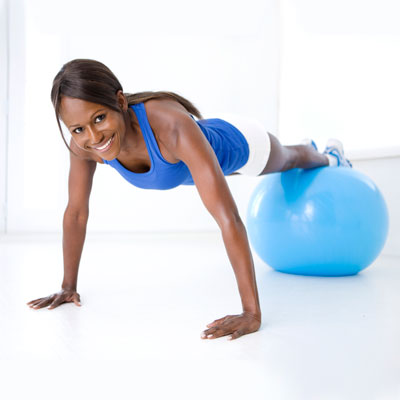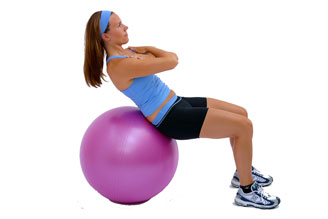Fitness Ball Biography
Source:- Google.com.pk
An exercise ball is a ball constructed of soft elastic with a diameter of approximately 35 to 85 centimeters (14 to 34 inches) and filled with air. The air pressure is changed by removing a valve stem and either filling with air or letting the ball deflate. It is most often used in physical therapy, athletic training and exercise. It can also be used for weight training. The ball, while often referred to as a Swiss ball, is also known by a number of different names, including balance ball, birth ball, body ball, ball, fitness ball, gym ball, gymnastic ball, physioball, pilates ball, Pezzi ball, sports ball, stability ball, Swedish ball, therapy ball, or yoga ball.
The physical object known as a "Swiss Ball" was developed in 1963 by Aquilino Cosani, an Italian plastics manufacturer. He perfected a process for molding large puncture-resistant plastic balls. Those balls, then known as "Pezzi balls", were first used in treatment programs for newborns and infants by Mary Quinton, a British physiotherapist working in Switzerland. Later, Dr. Susanne Klein-Vogelbach, the director at the Physical Therapy School in Basel, Switzerland, integrated the use of ball exercise as physical therapy for neuro-developmental treatment. Based on the concept of "functional kinetics", Klein-Vogelbach advocated the use of ball techniques to treat adults with orthopedic or medical problems. The term "Swiss Ball" was used when American physical therapists began to use those techniques in North America after witnessing their benefits in Switzerland. From their development as physical therapy in a clinical setting, those exercises are now used in athletic training,as part of a general fitness routine and incorporation in alternative exercises such as yoga and Pilates.A primary benefit of exercising with an exercise ball as opposed to exercising directly on a hard flat surface is that the body responds to the instability of the ball to remain balanced, engaging many more muscles. Those muscles become stronger over time to keep balance. Most frequently, the core body muscles — the abdominal muscles and back muscles — are the focus of exercise ball fitness programs.
A major benefactor of using an unstable surface is the ability to recruit more muscle units without the need to increase the total load. The greatest benefactor of moving an exercise onto an unstable surface is achieving a greater activation of the core musculature, exercises such as curl-up or push-up performed on a exercise ball An unstable surface increases activation of the rectus abdominus and allows for greater activity per exercise when compared to a stable surface. Exercises such as a curl-up on a exercise ball yields a greater amount of electromyography (EMG) activity compared to exercises on a stable platform. Performing standard exercises, such as a push-up, on an unstable surface can be used to increase activation of core trunk stabilizers and in turn provide increased trunk strength and greater resistance to injury.
Other uses[edit]
Some people recommend sitting on an exercise ball instead of a chair (for example, an office chair). This is based on the theory that the abdominal and back muscles are constantly engaged and active in order to maintain proper posture and balance on the ball. There is no scientific evidence of those benefits occurring by just sitting without additional exercises. However, some people warn against using a Swiss ball as a chair due to ergonomic considerations or biomechanical reasons.
This large plastic ball, known as a "birth ball", can also be used during labour to aid the descent of the fetal head into the pelvis. Sitting in an upright position will also aid fetal positioning and is more comfortable for the woman. Sitting on the ball with arms placed on a bed, table or otherwise sturdy object for support and gently rocking the hips may help the woman during contractions and aid the natural physiological process of birth.
A medicine ball (also known as an exercise ball, a med ball, or a fitness ball) is a weighted ball roughly the diameter of the shoulders (approx. 13.7 inches), and is often used for rehabilitation and strength training. The medicine ball also serves an important role in the field of sports medicine. However, it should not be confused with the larger, inflated exercise ball.
Medicine balls are usually sold as 2–25 lb (0.91–11.34 kg) balls and are used effectively in plyometric weight training to increase explosive power in athletes in all sports. Some medicine balls are in the form of weighted basketballs.
A BOSU Balance Trainer, or BOSU ball as it is often called, is a fitness training device, invented in 1999 by David Weck, consisting of an inflated rubber hemisphere attached to a rigid platform. It is also referred to as the "blue half-ball", because it looks like a stability ball cut in half. The name is an acronym which stands for "BOth Sides Up" a reference to the two ways a BOSU ball can be positioned. The device is often used for balance training. When the dome side faces up, the BOSU ball provides an unstable surface while the device remains stable. This combination of stable/unstable allows a wide range of users, from the young, elderly, or injured to the elite level athlete. With the dome side up, the device can be used for athletic drills and aerobic activities. As the name suggests, the device can also be flipped over so that the platform faces up. In this position, the device is highly unstable and can be used for a wide array of exercises as well.
Fitness Ball Fitness Motivation Quotes Models Inspiration Motivational Quotes Women Logo Girl First Selfies
Fitness Ball Fitness Motivation Quotes Models Inspiration Motivational Quotes Women Logo Girl First Selfies
Fitness Ball Fitness Motivation Quotes Models Inspiration Motivational Quotes Women Logo Girl First Selfies
Fitness Ball Fitness Motivation Quotes Models Inspiration Motivational Quotes Women Logo Girl First Selfies
Fitness Ball Fitness Motivation Quotes Models Inspiration Motivational Quotes Women Logo Girl First Selfies
Fitness Ball Fitness Motivation Quotes Models Inspiration Motivational Quotes Women Logo Girl First Selfies
Fitness Ball Fitness Motivation Quotes Models Inspiration Motivational Quotes Women Logo Girl First Selfies
Fitness Ball Fitness Motivation Quotes Models Inspiration Motivational Quotes Women Logo Girl First Selfies
Fitness Ball Fitness Motivation Quotes Models Inspiration Motivational Quotes Women Logo Girl First Selfies
Fitness Ball Fitness Motivation Quotes Models Inspiration Motivational Quotes Women Logo Girl First Selfies
Fitness Ball Fitness Motivation Quotes Models Inspiration Motivational Quotes Women Logo Girl First Selfies










Thanks for sharing nice information about exercise ball for muscle fitness ball with us. i glad to read this post.
ReplyDeleteThanks a lot for sharing this amazing knowledge with us. This site is fantastic. I always find great knowledge from it. Gymnastic Ball Manufacturer
ReplyDelete